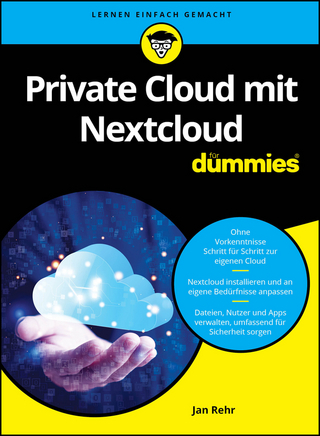
Using Samba
O'Reilly Media (Verlag)
978-1-56592-449-9 (ISBN)
- Titel ist leider vergriffen;
keine Neuauflage - Artikel merken
This book, which has been officially adopted by the Samba team under an open content license, is a comprehensive guide to Samba administration, including such recent additions as integration with Windows NT domains and the SWAT graphic configuration tool. Samba is a cross-platform triumph: it turns a Unix or Linux system into a file and print server for Microsoft Windows network clients. Now you can let users store their files (and even important executables) in a single place for easy sharing and backup, protected by Unix or NT security mechanisms, and still offer such transparent access that PC users don't even realize they're going to another system. The magic behind Samba is that it recognizes and speaks the SMB protocol developed by Microsoft for file and printer sharing on its own systems. Basic Samba configuration is simple, but you'll want to make sure your security settings are just right and find out about the full range of options (how do you like your filenames mangled?). Trouble-shooting, security, connectivity, performance, and logging are thoroughly covered with examples in this book.
Samba is so robust, flexible, and secure that many people are choosing it over Windows NT for their file and print services. Furthermore, Samba is proving to be a necessity for the many organizations that have an existing Unix or Linux system and want to tie in PCs running Microsoft software. Samba is also Open Source software, licensed under the GNU General Public License. The authors present the most common configurations and problems in an easy-to-follow manner, along with instructions for getting the most out of Samba. Whether you're playing on one note or a full three-octave range, this book will give you an efficient and secure server. The included CD-ROM holds sources and ready-to-install binaries, plus other useful information.
Robert Eckstein enjoys dabbling with just about anything related to computers. From rendering to electronic commerce to compiler construction to fuzzy logic, most of his friends agree that Robert spends far too much time in front of a computer screen. At O'Reilly, Robert works mostly on Java books (notably Java Swing) and is also responsible for the XML Pocket Reference and Webmaster in a Nutshell, 2nd Edition. In his spare time he has been known to provide online coverage for popular conferences. He also writes articles for JavaWorld magazine. Robert holds bachelor's degrees in computer science and communications from Trinity University. In the past, he has worked for the USAA insurance company and more recently spent four years with Motorola's cellular software division. He now lives in Austin, Texas, with his newlywed Michelle -- they both hope to adopt a talking puppy soon. David Collier-Brown is a consulting systems integrator, currently working for the performance and engineering group at Sun Opcom in Toronto. In his spare time he reads assiduously, keeps score for his wife's baseball team and, in the two weeks of the local summer, sails from Toronto's outer harbor. Peter Kelly works on his own as a Systems Consultant in Toronto, Canada specializing in Internet and network security. Peter is currently finishing exams to be an MCSE, but prefers to work with Linux when he can. When Peter is not working, he enjoys playing golf and reading about security, networking, and Calvin & Hobbes.
Preface 1. Learning the Samba What is Samba? What Can Samba Do For Me? Getting Familiar with a SMB/CIFS Network Microsoft Implementations An Overview of the Samba Distribution How Can I Get Samba? What's New in Samba 2.0? And That's Not All... 2. Installing Samba on a Unix System Downloading the Samba Distribution Configuring Samba Compiling and Installing Samba A Basic Samba Configuration File Starting the Samba Daemons Testing the Samba Daemons 3. Configuring Windows Clients Setting Up Windows 95/98 Computers Setting Up Windows NT 4.0 Computers An Introduction to SMB/CIFS 4. Disk Shares Learning the Samba Configuration File Special Sections Configuration File Options Server Configuration Disk Share Configuration Networking Options with Samba Virtual Servers Logging Configuration Options 5. Browsing and Advanced Disk Shares Browsing Filesystem Differences File Permissions and Attributes on MS-DOS and Unix Name Mangling and Case Locks and Oplocks 6. Users, Security, and Domains Users and Groups Controlling Access to Shares Authentication Security Passwords Windows Domains Logon Scripts 7. Printing and Name Resolution Sending Print Jobs to Samba Printing to Windows Client Printers Name Resolution with Samba 8. Additional Samba Information Supporting Programmers Magic Scripts Internationalization WinPopup Messages Recently Added Options Miscellaneous Options Backups with smbtar 9. Troubleshooting Samba The Tool Bag The Fault Tree Extra Resources A. Configuring Samba with SSL B. Samba Performance Tuning C. Samba Configuration Option Quick Reference D. Summary of Samba Daemons and Commands E. Downloading Samba with CVS F. Sample Configuration File
| Erscheint lt. Verlag | 7.12.1999 |
|---|---|
| Zusatzinfo | Ill. |
| Verlagsort | Sebastopol |
| Sprache | englisch |
| Maße | 178 x 232 mm |
| Gewicht | 680 g |
| Einbandart | kartoniert |
| Themenwelt | Mathematik / Informatik ► Informatik ► Betriebssysteme / Server |
| Mathematik / Informatik ► Informatik ► Datenbanken | |
| ISBN-10 | 1-56592-449-5 / 1565924495 |
| ISBN-13 | 978-1-56592-449-9 / 9781565924499 |
| Zustand | Neuware |
| Informationen gemäß Produktsicherheitsverordnung (GPSR) | |
| Haben Sie eine Frage zum Produkt? |
aus dem Bereich



